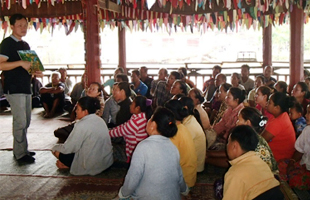
The World Health Organization (WHO) is working with communities across the Western Pacific Region to improve water safety and prevent water-borne diseases such as schistosomiasis. This story describes action in the Mekong region to eliminate schistosomiasis as a public health problem. Schistosomiasis can cause not only anaemia and stunting but also death in severe cases.
Schistosomiasis in the Mekong River
The Mekong River is vital to populations of the Mekong region, especially to people living in nearby villages. The river is the main source of water and income from farming and fishing. However, it is also home to the snail Neotricula aperta, the host of Schistosoma mekongi, a schistosomiasis-causing worm.
Schistosomiasis is endemic in approximately 300 villages of Champassak province in the Lao People's Democratic Republic, and Kratie and Stung Treng provinces in Cambodia, a stretch of approximately 250 kilometres along the Mekong River.
After years of targeted interventions to prevent and treat the disease, Cambodia and the Lao People's Democratic Republic are moving closer to elimination of schistosomiasis as a public health problem. Additional activities are now underway to reach this goal.
Efforts to eliminate the disease
A treatment method known as annual mass drug administration (MDA) has been ongoing for over 10 years and has resulted in progress both in Cambodia and the Lao People's Democratic Republic. In addition to MDA, communities are working on complementary activities and interventions such as improving water quality, sanitation and hygiene, and health education to reduce risk behaviours among villagers.
The community-led initiative to eliminate schistosomiasis and reduce soil-transmitted helminthiases (CL-SWASH) aims to build on national water, sanitation and hygiene efforts by developing water safety plans in schistosomiasis-endemic communities in both countries.
Case study: Had Xaykhoun village
CL-SWASH is underway in Had Xaykhoun village in the Lao People's Democratic Republic, home to approximately 1600 people. Activities will be conducted across 250 households. The village has set up a water safety plan team, composed of seven elected volunteer members, including a representative of the local Women’s Union. The team will use the village fund to promote, oversee and monitor construction of improved sanitation facilities, conduct inspections, assess risks, and support facility maintenance and repairs. Villagers have also identified activities to reduce transmission of schistosomiasis, such as improving household water treatment and storage, and constructing pens for free-roaming dogs and pigs.
This is already producing results. In 2016, the proportion of households with access to improved sanitation facilities in Had Xaykhoun reached 80% up from less than 60% in 2015 when data collection started.
Future directions
With support from WHO and the Government, communities like Had Xaykhoun are leading implementation of CL-SWASH. The national CL-SWASH teams in both countries have finalized joint action plans and launched national task forces. Collaboration among partners
in neglected tropical diseases (NTDs), WASH, animal health, education and nutrition is being promoted to put plans into action. Through this integrated approach, CL-SWASH aims to contribute to the elimination of schistosomiasis in the Western Pacific
Region by 2020.




